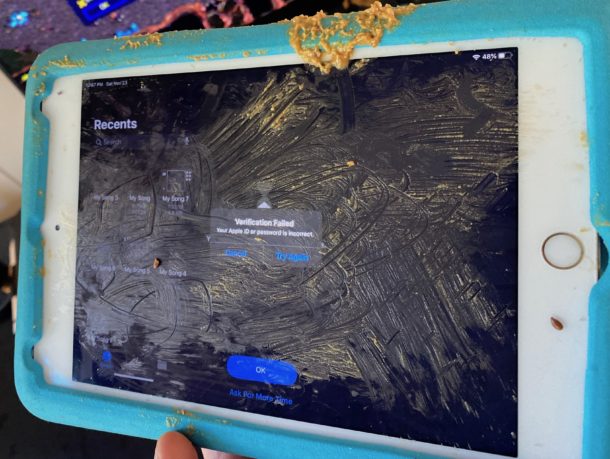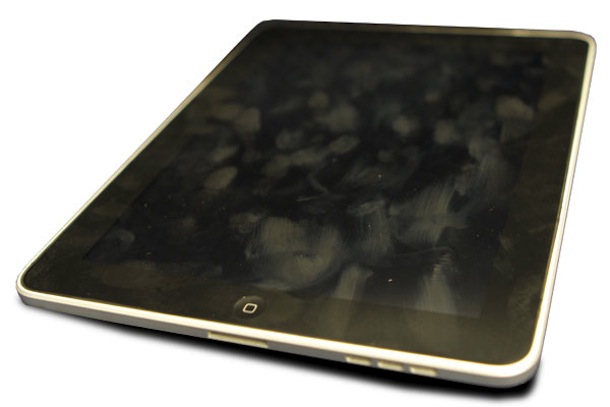How to Clean the iPad Screen

The iPad has a beautiful screen, there’s no doubt about that, but once you’ve handled it for a while you might notice the screen gets dirty. And of course if your hands are dirty, the display of the iPad will get dirtier more quickly. The dirty iPad screen factor really grows if you let children use iPads too, as the display can pick up whatever is on their hands and fingers. Perhaps the worst thing about the iPad is that it shows up fingerprints and smudges so easily, this is despite the fact that the screen has an anti-oil coating on it, and many of us like to keep that nice shiny black glass looking as pristine as possible.
So, how do you clean the iPad screen? Fortunately cleaning the iPad display is quite easy to do safely. This applies to all iPad models, including iPad, iPad Pro, iPad mini, and iPad Air.
How to Clean the iPad Screen the Right Way
The proper way to clean the iPad display is to use nothing but a soft damp cloth:
- Turn off the iPad and disconnect it from any accessories, cables, or docks
- Using a very soft and slightly damp cloth (with clean water), gently wipe the iPad screen. Be sure to not allow moisture to get into the openings of the iPad
- Repeat until the iPad screen is clean again
You can use cotton cloth, a towel, microfiber, or even a soft paper towel. Just make sure whatever you are rubbing on the iPad screen is very soft and clean itself. You don’t want to use anything that could leave scratches on the iPad screen as you clean it up.

What if the iPad is ultra dirty with grease, pizza, peanut butter, or just super dirty?
If the iPad screen is extra dirty, again use a damp cloth to wipe it down.
It may take several wipes to clean the screen sufficiently, but using only a damp cloth with water is the best way to safely clean iPad screens.
Can I clean the iPad screen with Windex, Alcohol, or Window Cleaner?
No, using abrasive or chemical cleaners is strongly not recommended. So do NOT use Windex, chemical cleaners, or window cleaners! These type of harsh chemical cleaners can damage the screen by stripping away the coating on the display.
This includes rubbing alcohol, nail polish remover, glass cleaner, ammonia products, bleach, and the like.
The chemicals in industrial and many household cleaners and these products can damage the oleophobic screen coating and actually make the iPad screen less responsive to touch over time.
So that is not worth it, do not use chemical cleaners! Stick to a damp cloth and water to clean the iPad screen
What can prevent the iPad screen from showing fingerprints and getting dirty?
Your best bet to keeping the iPad screen clean is to just wipe it down frequently with a soft cloth.
If you get annoyed with the fingerprints though, you can use a screen protector product like any of the iPad screen protectors on Amazon which double both as a way to protect the screen from scratches and also reduces the appearance of fingerprints. There are other similar screen protector products that may also help to keep the iPad screen clean and perhaps ward off scratches and other damage too.
It’s worth pointing out there are also anti-glare iPad screen protectors available if both the glare and the fingerprints bother you.
So the next time you want to clean the iPad screen, just use a lightly damp cloth and gently wipe down the screen. Repeat, until the screen looks nice and clean again. That’s all there is to it, don’t use chemicals or abrasives, keep it simple!


I can confirm this is true. I have done it myself. Just now.
The ipad and iphone come from the factory with an “oleophobic”, meaning oil repelling, coating which windex most certainly disolves and breaks down.
If you use basically anything but water, you will degrade the coating. I just used windex to clean off the entire coating intentionally. The tiniest bit of windex and microfiber wiping was all that was required. It was EASY to do, so don’t think “a little bit won’t harm it”.
You can always apply another oleophobic layer if you wish, though doing so perfectly uniformly and optically perfectly is difficult.
The oleophobic coating is NOT related to digitizer (touchscreen) function. The touchscreen works great without it, better in fact! However, humans are oily creatures.
Everytime we touch ANYTHING we leave a little of that oil behind. Over time this oil accumulates and polymerizes (into a hydrophobic coating) not unlike what you end up with on a cast iron pan after multiple seasonings. This CAN (hypothetically. It is unlikely to cause much serious issue normally) make a touchscreen less sensitive, especially when the layer is non-uniform as it will be when you are normally using any touchscreen without gloves.
In my particular case, I was cleaning the screen to put a plastic screen protector on to it. In cases like this, go ahead and wipe the oleophobic coating entirely off if you wish – but know that you can’t go back without some effort and you will be a “screen protector” person from then on out.
Alternatively you could wipe the entire coating off, use the thing normally, and whenever you have any touchpad issues clean it thoroughly again with whatever glass cleaner your heart desires. If you’ve already wiped off some of the coating (accidentally or otherwise) and it now looks “patchy” or non-uniform, I would recommend finishing the job and using more cleaner until the screen sparkles once more. Use microfiber, NOT paper towel; this is to avoid making noticible scratches on the glass and not a good idea to skip or substitute.
Well this is good to know. I have a friend who uses an ammonia spray on their iPhone and iPad screen and then later said their screens looked strange and didn’t work as well, I wonder if the coating was removed and it damaged the display when trying to clean it? Water works, use that I guess.
It’s true – you’ll want to stick with a professional product and cloth like fountonium (http://fountonium.com) to make sure the oleophobic coating stays intact.
From apple’s website:
“iPad has an oleophobic coating on the screen; simply wipe iPad’s screen with a soft, lint-free cloth to remove oil left by your hands. The ability of this coating to repel oil will diminish over time with normal usage, and rubbing the screen with an abrasive material will further diminish its effect and may scratch your screen.”
Why in the world would it make the screen less responsive?! Alcohol cannot damage the glass itself nor the touchscreen underneath.
Please explain your reasoning and give evidence to such statements, lest you want to be spreading BS rumours.
Good morning to you to.
There is a special coating on the screen, chemicals and abrasives can damage this coating. This is not a “BS rumour” it is a known fact from Apple’s iPad user guide:
“iPad has an oleophobic coating on the screen; simply wipe iPad’s screen with a soft, lint-free cloth to remove oil left by your hands. The ability of this coating to repel oil will diminish over time with normal usage, and rubbing the screen with an abrasive material will further diminish its effect and may scratch your screen.”
http://manuals.info.apple.com/en_US/iPad_Important_Product_Information_Guide.pdf
You are free to use whatever you want on your screen, but I would not recommend straying from Apple’s guidelines if you wish to maintain your screens usability and the devices warranty.